Processing of Agricultural Products and Food
80000-ton/year Feed-grade Amino Acid Production Project of Baicheng City
1 Introduction to the Project
1.1 Project background
1.1.1 Product introduction
Feed-grade amino acid refers to purified amino acid or amino acid mixture used in animal feed, which are widely used in the feed of poultry, pigs, cattle and other livestock and poultry to improve the nutritional value of the feed and the growth rate of animals. Feed-grade amino acid can also be used to replace natural proteins, reduce unnecessary nitrogen load in feed components, and lower nitrogen pollution emissions from livestock and poultry.
The raw materials for amino acid production are mainly extracted from grain products. This project utilizes the abundant resource advantages of Zhenlai County to produce 80000 tons of feed-grade amino acid annually, mainly including feed grade valine, feed grade tryptophan, and feed grade isoleucine.
1.1.2 Market prospect
(1) Amino acid industry chain
Amino acid is an organic compound containing basic amino groups and acidic carboxyl groups, and is the basic substance that makes up the protein required for animal nutrition.
The upstream of the amino acid industry chain is the raw material supply link. The raw materials for amino acid production are mainly extracted from grain products. The midstream of the amino acid industry chain is the production link. The downstream of the amino acid industry chain is the demand link. Amino acid is used as raw materials for manufacturing antibody proteins, hemoglobin, enzyme proteins, hormone proteins, etc. in organisms, and can even provide energy sources for organisms. Amino acid is closely related to biological life activities and play a crucial role in nutrition and health fields such as feed, food, and medicine.
(2) Market situation of the amino acid industry
The world amino acid industry emerged in the 1950s. Due to developed countries such as Japan, Europe, and America starting early in the field of amino acids, they have long been at the forefront of the world in terms of technological level, innovation ability, and high-end products. International leading enterprises all occupy a high global market share. With the rapid development of the global economy, the application fields of amino acids continue to expand, and the global amino acid market is huge and showing a stable growth trend. The global amino acid market size was approximately 26.19 billion US dollars in 2021, and 27.11 billion US dollars in 2022, a year-on-year increase of 3.51%. It is expected that the global amino acid market size will have grown to nearly 40 billion US dollars by 2027.
Figure 1 Global Market Sizes and Growth Rates of the Amino Acid Industry from 2018 to 2022
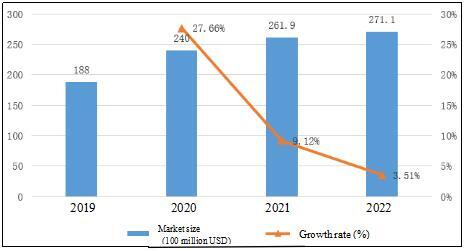
The amino acid industry in China started in the early 21st century and has developed to become a global amino acid production base. The production of lysine, threonine, and methionine, the three major amino acids, ranks first in the world, with large output and mature production processes. Its life cycle is already in the mature stage. The small variety amino acid market represented by tryptophan and valine is in a period of rapid development, especially with the development of genetic engineering technology applied to microbial gene structure, which will further promote the great development of the amino acid industry.
In 2022, the size of China’s amino acid market reached about 35 billion yuan, a year-on-year increase of 6%; the total production of amino acids in China in 2022 was about 4.5 million tons, an increase of 7% compared to the previous year; the domestic consumption during the same period was about 3.8 million tons, a year-on-year increase of 5%.
In 2022, the main application areas of amino acid in China are feed additives, food processing, pharmaceuticals and health products, and other fields such as cosmetics and agriculture. The consumption of amino acid for feed additives is about 2.28 million tons, accounting for 60% of the total consumption; the consumption for food processing is about 950000 tons, accounting for 25% of the total consumption; the consumption for pharmaceuticals and health products is about 380000 tons, accounting for 10% of the total consumption; the consumption for other fields (such as cosmetics, agriculture, etc.) is about 190000 tons, accounting for 5% of the total consumption.
Figure 2 Consumption of Amino Acid in Major Application Fields in China in 2022 (Unit: 10000 tons)
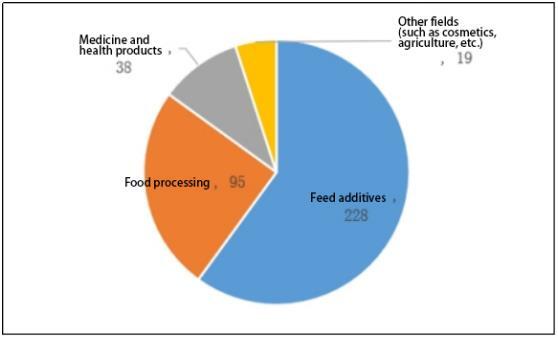
(3) Market situation of the feed-grade amino acid industry in China
Feed-grade amino acid is an important part of the development of the modern animal husbandry, which can significantly improve the nutritional value of feed and the growth rate of animals, and reduce nitrogen pollution. The artificial synthesis technology of feed-grade amino acid is constantly developing, and the types of amino acid that can be synthesized are gradually increasing. The significant increase in feed production has driven the overall growth of China’s feed amino acid industry. The production of feed amino acid in China has increased from 2.67 million tons in 2018 to 4.332 million tons in 2023, with a year-on-year growth rate of 12.37%.
Figure 3 Scales and Growth Rates of China’s Feed-grade Amino Acid Industry from 2018 to 2023
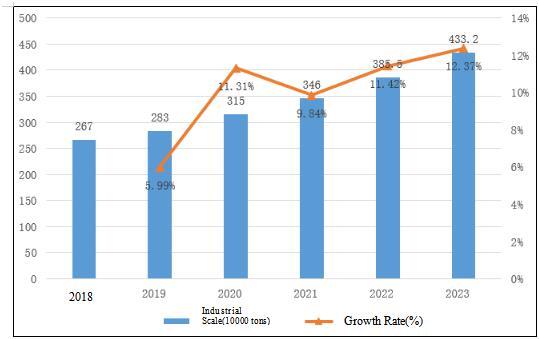
(4) Market analysis of the project
The main varieties of feed-grade amino acid include lysine, threonine, methionine, tryptophan, etc. Lysine is the first limiting amino acid in pig feed, and its deficiency can affect animal growth and health. Threonine is a limiting amino acid during the growth stage of young pigs and plays an important role in their growth. Methionine has a significant impact on the growth and reproduction of pigs, and deficiency can lead to growth retardation. Tryptophan has a typical unique odor and is mainly used to meet the specific nutritional needs of animals. Therefore, feed-grade amino acid is essential nutrients for animal growth and development, widely used in animal husbandry, and playing an important role in improving feed utilization and reducing breeding costs.
With the growth of the global population and the improvement of living standards, the demand for animal protein continues to increase. In addition, the increasing demand for healthy food from consumers has prompted the livestock industry to pay more attention to the use of high-quality feed additives, which has increased the demand for feed-grade amino acid and further promoted the growth of the feed-grade amino acid market.
The abundant grain products in Zhenlai County provide sufficient raw material sources for the production of feed-grade amino acid, and the market prospects for the products are broad.
1.1.3 Technical analysis
At present, the commonly used production methods for amino acid include protein hydrolysis, chemical synthesis, microbial fermentation, and enzymatic methods. Microbial fermentation is currently a widely used method.
The entire production process of microbial fermentation can be roughly divided into four stages, namely: strain stage, seed expansion and cultivation stage, fermentation stage, and extraction stage. The specific steps are as follows:
Pure separation → Parent culture → Steam→ Air compressor → Steaming and sterilization → Parent culture → pH regulator → Fermentation tank → Sterilizer → Culture medium → Preparation tank → Centrifugal separator → Ion exchange column → Crystallization tank → Crystal separator → Dryer → Amino acid product
1.1.4 Advantageous conditions of project construction
(1) Policy advantages
In March, 2021, the Outline of the 14th Five-Year Plan and Long-range Objectives for 2025 of the People’s Republic of China proposed to enrich rural economic formats, promote the integrated development of primary, secondary, and tertiary industries in rural areas, and improve the development level of agricultural product processing industry and agricultural productive service industry.
In March, 2021, the Ministry of Agriculture and Rural Affairs issued the Work Plan for Reducing and Replacing Corn and Soybean Meal in Feed, proposing to fully tap and utilize existing feed resources, establish accurate nutritional value parameters, optimize and adjust feed formula structure, construct a diversified feed formula system with Chinese characteristics, reduce the proportion of corn and soybean meal in feed, and provide strong technical support for ensuring the balance of feed and grain supply and demand and stabilizing food security.
In April, 2023, the Ministry of Agriculture and Rural Affairs released the Three-Year Action Plan for Reducing and Replacing Feed Soybean Meal, proposing to target low protein, low soybean meal, diversification, and high conversion rate, focusing on “improving quality and efficiency, and increasing feed sources”, coordinating the use of protein feed resources such as plants, animals, and microorganisms, promoting comprehensive measures such as efficiency improvement, open source, and structural adjustment, strengthening the integrated innovation and promotion of new feed products, new technologies, and new processes, guiding the feed breeding industry to reduce soybean meal consumption, promoting feed grain conservation and consumption reduction, and making contributions to ensuring stable and safe supply of food and important agricultural products.
(2) Resource advantages
Zhenlai County covers an area of 4718.69 square kilometers, with a total of 187300 hectares of arable land, 404.19 hectares of garden land, 40300 hectares of forest land, 41100 hectares of grassland, 13800 hectares of urban and industrial land, 9563.47 hectares of transportation land, 95200 hectares of water bodies and water conservancy facilities, and 84200 hectares of other land. Adequate industrial and construction land.
Zhenlai County has abundant power resources. The county can develop a wind farm of 400 square kilometers with an installed capacity of 2.1 million kilowatts. Zhenlai County has 2892 hours of sunshine hours and an annual total solar radiation of 124.71 kilocalories per square centimeter, ranking among the top in the province in terms of sunshine hours and radiation. It is suitable for building a solar power plant with an area of 400 square kilometers.
(3) Industrial advantages
Zhenlai County is the largest rice planting county and one of the main corn producing areas in Jilin Province. In 2024, the rice planting area in Zhenlai County is 1.55 million mu, with a yield of 2.06 billion jin and increase of 10 million jin; the corn planting area is 1.15 million mu, an increase of 30000 mu from the previous year, with a yield of 1.55 billion jin and increase of 50 million jin; the planting scale and yield of other grain crops such as soybeans, wheat, potatoes, and miscellaneous grains and beans are basically the same as in previous years.
Zhenlai County can utilize a grassland area of 87300 hectares, relying on Asia’s largest Feihe 30000-cow monoculture pasture, Jitianran 10000-cattle fattening project, and Hehe Animal Husbandry’s “Hehe Cattle” series of trademarks, to create a local characteristic brand of “Jilin Province’s largest dairy county”, “Jilin Province’s livestock breeding county”, and “Zhenlai beef cattle”. Focus on introducing industrial projects such as feed, packaging, slaughtering, cattle and sheep skin processing, organic fertilizer conversion of livestock and poultry manure, and biopharmaceuticals that are complementary to the upstream and downstream of the industrial chain.
(4) Location advantages
Zhenlai County is located at the junction of the three major resource provinces (regions) of Heilongjiang, Jilin, and Inner Mongolia, and is known as the place “where rooster crowing can be heard in three provinces”. Within a radius of 200 kilometers, it is surrounded by five prefecture level cities (Songyuan, Baicheng, Qiqihar, Daqing, Ulanhot) and five regional airports, and is only 40 kilometers away from Baicheng Airport. There are two railways and two highways intersecting within the territory, making it an important “hub” city at the junction of Heilongjiang Province, Jilin Province, and Inner Mongolia. It is a must pass place for Inner Mongolia and Heilongjiang to enter the country, with convenient transportation and developed logistics, and has strong advantages in radiation and driving.
(5) Talent advantages
There are several research institutes in Baicheng City, including the Academy of Agricultural Sciences, the Academy of Forestry Sciences, the Agricultural Machinery Research Institute, the Livestock Research Institute, and the Research Institute. There are 40873 professional and technical personnel, including 6898 with senior professional titles, 18409 with intermediate professional titles, and 15566 with junior professional titles. Baicheng Academy of Agricultural Sciences is the only comprehensive agricultural research institution in the semi-arid special ecological zone of western Jilin Province. It leads the country in research on oats, sunflowers, miscellaneous grains and beans, and is the forefront and main research group for agricultural technology innovation and promotion in western Jilin Province.
1.2 Contents and scale of project construction
1.2.1 Product scale
After the project is completed, it will process 180000 tons of corn annually, produce 50000 tons of feed-grade valine, 15000 tons of feed-grade tryptophan, and 15000 tons of feed-grade isoleucine.
1.2.2 Construction contents of the project
The project covers an area of 100000 square meters and has a building area of 70000 square meters. It mainly includes the construction of the corn pre-purification workshop, sugar production workshop, fermentation workshop, feed workshop, air compression station, circulating water station, liquid ammonia station, sewage station, power workshop, various warehouses and related facilities such as testing, logistics, and office buildings.
1.3 Total investment of the project and capital raising
1.3.1 Total investment of the project
The total investment of the project is 800 million yuan, including the construction investment of 730 million yuan and current funds of 70 million yuan.
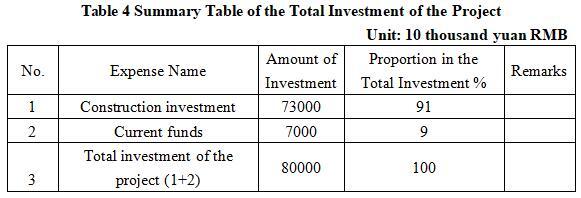
1.3.2 Capital raising
Self-financing by the enterprise
1.4 Financial analysis and social evaluation
1.4.1 Main financial indexes
After the project reaches the production capacity, its annual sales revenue will be 662 million yuan, its profit will be 180 million yuan, its investment payback period will be 6.4 years (after the tax, including the construction period of 2 years) and its return on investment will be 22.5%.
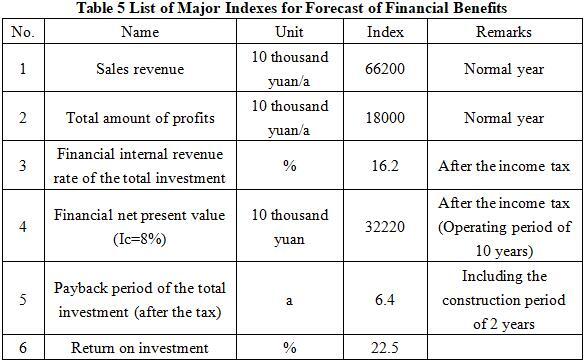
Note: “10 thousand yuan” in the table is in RMB.
1.4.2 Social evaluation
After the completion of the project, through the promotion of amino acid production, high-quality amino acids will be produced to drive the deep processing of agricultural products and the development of related industries in Baicheng and surrounding areas, promote industrial structure adjustment, transformation and upgrading, and regional economic development. The project can provide employment opportunities for social personnel and has a significant impact on the harmonious development of regional society.
1.5 Cooperative way
Sole proprietorship or joint venture
1.6 What to be invested by the foreign party
Funds, equipment or technology
1.7 Construction site of the project
Zhenlai County, Baicheng City
1.8 Progress of the project
The project proposal has been prepared.
2 Introduction to the Partner
2.1 Basic information
Name: Zhenlai Project Development Service Center
Address: 1777 Xinxing South Street, Zhenlai Town, Zhenlai County, Baicheng City
2.2 Overview
Zhenlai County is located in the northwest of Jilin Province, at the junction of Jilin Province, Heilongjiang Province, and Inner Mongolia, and is a convergence zone of the Songnen Plain and the Horqin Grassland. To the east is the Nenjiang River, facing Duerbote Mongolian Autonomous County and Zhaoyuan County in Heilongjiang Province across the river, to the west is Ulanhot City in Inner Mongolia Autonomous Region, to the north is Tailai County in Heilongjiang Province and Zhalaite Banner in Inner Mongolia Autonomous Region, and to the southwest and south are adjacent to Baicheng City, Da’an City, and Taobei District respectively. Zhenlai County is a large-scale commodity grain base and livestock development demonstration base in China. The location and transportation advantages of Zhenlai County are obvious, with Zhenlai County as the center and a radius of 500 kilometers, which can comprehensively cover industrial cities and resource rich areas in the northeast region.
In 2023, the county’s GDP reached 9.48 billion yuan, a year-on-year increase of 6.6%; the fixed assets investment reached 2 billion yuan, up 23.6% year on year; the total output value of industrial enterprises above the designated size reached 2.7 billion yuan, a year-on-year increase of 9%; the added value of industrial enterprises above the designated size reached 780 million yuan, a year-on-year increase of 7%; the total retail sales of consumer goods reached 1.42 billion yuan, a year-on-year increase of 7%; the local level fiscal revenue reached 400 million yuan, a year-on-year increase of 20%; the per capita disposable income of urban residents increased by 8% year-on-year; the per capita disposable income of rural residents increased by 9% year-on-year.
2.3 Contact method
2.3.1 Contact method
Contact unit: Zhenlai Project Development Service Center
Contact person: Tian Tian
Tel: +86-15886168765
2.3.2 Contact method of the city (prefecture) where the project is located
Contact unit: Baicheng Bureau of Commerce
Contact person: Xu Zengchun
Tel: +86-436-3203010
+86-13894682986
E-mail: bcjhj07@126.com


